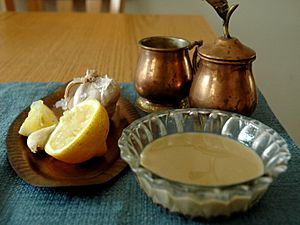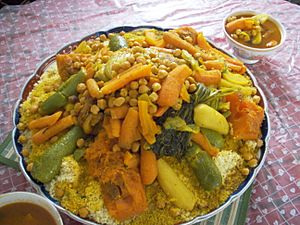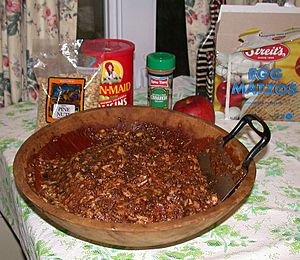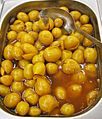Mizrahi Jewish cuisine facts for kids
- Further information: Jewish cuisine, Sephardic Jewish cuisine, Ashkenazi Jewish cuisine, Ethiopian Jewish cuisine, Bukharan Jewish cuisine, Syrian Jewish cuisine, and Israeli cuisine
Mizrahi Jewish cuisine is a collection of cooking styles. These styles come from Jewish people who lived in the Middle East, North Africa, Asia, and Arab countries. These Jewish communities are known as Mizrahi Jews. The word Mizrahi means "Eastern" in Hebrew.
Mizrahi Jews cook foods that are popular in their home countries. They always follow the rules of kashrut, which means the food is prepared in a special way to be acceptable. Their cooking uses lots of fresh ingredients. This is because people often bought food from local markets called souqs.
Meat is prepared using a special process called shechita. It is then soaked and salted. Meat dishes are a big part of meals for Shabbat (the Jewish day of rest), holidays, and celebrations.
Cooked, stuffed, and baked vegetables are very important in this food style. Different kinds of beans, chickpeas, lentils, and bulgur (cracked wheat) are also common. Rice is often used instead of potatoes.
Contents
History of Mizrahi Food

Mizrahi Jews lived in the Middle East and areas to the south and east. This includes places along the Mediterranean Sea. After 1492, many Jews were forced to leave Spain. Some of them moved to these Eastern countries. This led to a mix of different food traditions.
Mizrahi Jewish food includes dishes from Jews in Iraq, Syria, Lebanon, Yemen, Iran, Afghanistan, Egypt, Berber communities, Kurdistan, and the Caucasus region.
Some of these food styles are similar to Sephardic Jewish food. Sephardic Jews also moved to many Eastern and North African countries after leaving Spain.
Mizrahi food often feels light and fresh. This is because it comes from sunny places near the Mediterranean. It uses many salads, stuffed vegetables, and vine leaves. Olive oil, lentils, fresh and dried fruits, herbs, and nuts are also common. Chickpeas are used a lot too.
Meat dishes often use lamb or ground beef. Fresh lemon juice is added to many soups and sauces. Many meat and rice dishes include dried fruits like apricots, prunes, and raisins. Pine nuts are used to decorate dishes. Pomegranate juice is a key ingredient in Persian-Jewish cooking.
Kubbeh is a special dish. It's a dumpling made from bulgur (cracked wheat) and filled with meat. Many Mizrahi communities enjoy it. It is often served in a broth, like a soup.
Breads in Mizrahi Cuisine
Flatbreads are very important in Middle Eastern cooking. There are many types of flatbreads. These include pitas, laffa, malawah, and lavash. These breads are used instead of challah. Challah was mostly used by Ashkenazi Jews in Europe. Moroccan Jews used a turban-shaped challah. Lahoh is a flatbread from Yemenite Jews. It has a soft, spongy texture.
Herbs, Spices, and Seasoning Blends
Mizrahi cooking uses a lot of cumin, pepper, and sesame seeds. It also uses many other spices found in Middle Eastern food. Saffron is also used in some Mizrahi dishes.
Many foods get their flavor from special spice mixes or pastes. They also use light sauces. Hilbah is a paste made from fenugreek seeds and hot pepper. It is added to soups and other traditional Yemenite dishes. Skhug is a hot pepper sauce. It comes in red and green types. A milder version of skhug is often put on falafel. Hawaij is a Yemenite spice mix with two main types. One type has powdered ginger, cinnamon, cloves, and cardamom. It is added to coffee and baked goods. The other type has turmeric, black pepper, onion, cumin, cardamom, and cloves. This one is added to soup.
Pastes and sauces are often served in small dishes on the side. People can add them to their food as they like. Some spice mixes are special to certain countries. For example, coriander and cumin are common in Egyptian food.
Markets (souqs) in the Middle East sell ready-made spice mixes. But Mizrahi Jews traditionally bought fresh herbs. They would make their own mixes at home. This helped them keep kashrut rules. They worried about insects in the mixes sold in open markets.
Here are some examples of spice blends:
- Hawaij (Yemen)—black pepper, cardamom, turmeric, saffron
- Kama (Morocco)—black pepper, cumin, ginger, turmeric, nutmeg
- Za'tar—a mix of za'atar (a type of herb), thyme or hyssop, ground sesame seeds, sumac, and salt
Sweet Treats

Hot sahlab is a warm, thick drink. It's like a cornstarch pudding. It used to be flavored with orchid powder. Today, artificial flavors are often used. It is served in cups in winter. It's topped with cinnamon, nuts, coconut, and raisins. Arak is a popular alcoholic drink. It tastes like anise. Rosewater is often used in cakes and desserts. Malabi is a cold cornstarch pudding. It is sprinkled with rosewater and red syrup.
Ikaddaif or kadaif is a very sweet pastry. It is similar to baklavah. It is made from shredded dough. This dough is wrapped around crushed nuts, baked, and then soaked in sweet syrup. It is common in many parts of the Middle East. It is often served at special meals.
Cooking Methods
Cooking is not allowed on Shabbat (the Jewish day of rest). So, Mizrahi Jews use slow-cooking methods. They bake food at a low temperature overnight. This way, they have hot dishes ready for Shabbat. This method is used in almost all Jewish cooking. One famous dish cooked this way is hamin or chamin. The word kham means "hot."
In North Africa, this dish is called dafina. There are many kinds of hamin and dafina. They use local spices and ingredients. The way they are made also changes. Some types are thicker than others. Some use rice instead of common root vegetables.
Bourekas are often eaten on Shabbat morning. In Yemenite cooking, Shabbat dishes include jachnun and kubbanah.
Shabbat and Holiday Meals
Shabbat
Shabbat foods are often cooked slowly before Shabbat begins. They are kept warm overnight once cooked. This is because cooking is forbidden on Shabbat by Jewish Law. In Yemenite cooking, Shabbat dishes include jachnun and kubaneh.
Passover
Mizrahi cooking allows the use of kitniyot during Passover. Kitniyot are legumes and some grains. This includes rice and different kinds of beans and pulses. Ashkenazi Jews do not eat kitniyot during Passover.
Charoset is a special dish eaten at Passover. In Ashkenazi homes, it's a mix of chopped apples and nuts with wine and cinnamon. Mizrahi charoset is often made from dried fruits, especially dates. It is much thicker.
Other Mizrahi Jewish dishes for Passover include tebit. This is a chicken and rice dish. Another is ingriyi, which is sweet and sour meat with eggplants. Both are from Iraqi Jewish cooking.
Rosh Hashanah
Makroudh are pastries filled with spiced dates. They are flavored with orange-flower water. Algerian Jews make them for Rosh Hashanah (the Jewish New Year).
Slow-cooked vegetables stuffed with meat are a popular holiday dish. Moroccan Jews season the stuffing with cinnamon, turmeric, and nutmeg. Holiday meals often begin with many small salads.
Gallery
-
Jachnun served with oven-baked egg, fresh grated tomato and zhug
Gastronomía sefardí tl:Lutuing Sefardi











